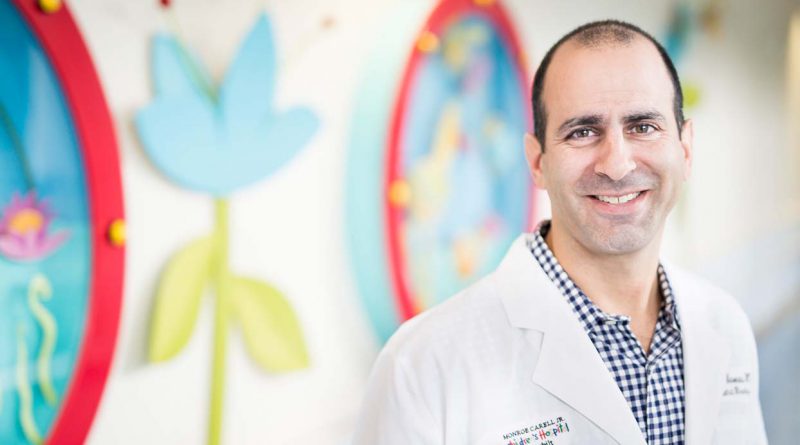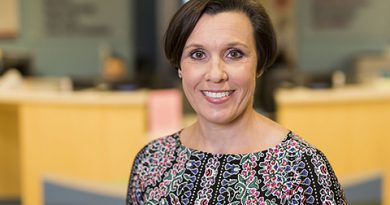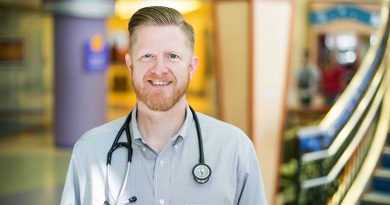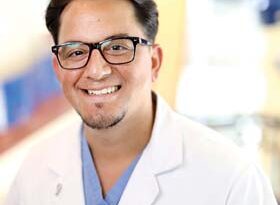Pioneers of Hope
Published on January 18th, 2018 by Diana Duren.
At Monroe Carell Jr. Children’s Hospital at Vanderbilt our work extends beyond patient exam rooms. We are also searching for discoveries to offer better treatments, provide quality care and train the next generation of clinicians. The profiles here represent only a sampling of the tireless work performed daily to make Children’s Hospital a place of unwavering hope. In each issue, we also include a profile to highlight our longstanding partnership with our community pediatricians who help ensure all children receive the best care each and every day.

Paul Moore, MD, understands firsthand the importance of quality and compassionate healthcare. His 12-year-old daughter, Caroline, the third of his four children, was born with Down syndrome and required open-heart surgery at 10 weeks of age.
“Having your own child go through surgery, you realize how vulnerable our families can be,” said Moore, director of the Division of Pediatric Allergy, Immunology and Pulmonary Medicine. “Everyone has the highest hopes for their children, and then to see them be born with a challenge, whether it’s short term or long term, you want to do everything you can in the world to provide for them. We are very blessed to live here. She’s in middle school now and thrives.”
His journey with Caroline’s health augmented a passion for his work as a pediatric pulmonary specialist, a career influenced by some of the great icons in the fields of pediatric pulmonology and neonatology.
Moore attended Vanderbilt University as an undergraduate, always interested in medicine. After Vanderbilt, he moved to Boston, where he spent 13 years. He earned a medical degree from Harvard Medical School, followed by a residency and fellowship at Boston Children’s Hospital. Boston is also where he met his wife, Catherine, and where he became a die-hard Red Sox baseball fan, a passion his four children now cherish.
While in Boston, he trained with a pioneer of pediatric pulmonary medicine — Mary Ellen Wohl, MD.
“She was a grand dame of pediatric pulmonary medicine and played a huge part in why I became interested in lung disease. She recruited me during residency to become a fellow. I had wonderful experiences in the clinical training as well as becoming involved in research at the Harvard School of Public Health,” said Moore, associate professor of Pediatrics and Pharmacology.
“For me, pediatric pulmonary medicine was an interesting career because it allowed me to take care of infants through adolescence; there were aspects of primary care in taking care of patients with cystic fibrosis and other pediatric lung diseases, and there were opportunities in the hospital to consult on some of the most complex patients.”
Moore came back to Vanderbilt in 2001 after Tom Hazinski, MD, recruited him to a growing and flourishing Division of Pediatric Pulmonary Medicine. Hazinski had built the division from scratch under neonatal medicine pioneer Mildred Stahlman, MD.
Moore’s research focus seeks to close some gaps in the understanding of lung disease. He recently completed one phase and is continuing another on Prematurity and Respiratory Outcomes Program (PROP), a study that looks at infants born at less than 29 weeks gestation and the development of bronchial pulmonary dysplasia or BPD. These infants are more likely to go home from the hospital on oxygen and are more at risk for asthma and other respiratory complications.
To help further advance care of children, Moore also serves as program committee chair for the American Thoracic Society’s Assembly on Pediatrics.
Ultimately, his patients and colleagues at Vanderbilt are what drive him.
“I am blessed to work with such a talented group of physicians, nurse practitioners and an entire team that is dedicated to children with allergic and respiratory disease,” said Moore. “Folks in our group are involved in studies in the lab that are translating into care for children with pulmonary diseases.”
When Moore isn’t devoting his time to patients, he and Catherine are busy with their children: Stewart, 16, Joseph, 14, Caroline, 12, and Mary Elizabeth, 10. He can be found on a soccer field, at a dance recital or on a family cross-country road trip.
– by Christina Echegaray
•••

Amber Greeno, RN, MSN, can’t remember a time when Vanderbilt wasn’t part of her life. She was 2 years old when her mother, Sandy, began working in the Surgical Intensive Care Unit at Vanderbilt University Medical Center. She has fond memories of going to work with her mom, playing in the former jungle gym on the first floor of the adult hospital and rolling around in wheelchairs in the conference rooms. Becoming a nurse was always in the cards.
“I think just growing up in that hospital environment, having all these nurses whenever I was sick come and check on me…I liked it,” she said. “I always thought it was a great job. I always looked up to my mother. She’s a strong woman. I think it was just a natural fit that I chose the nursing path.”
Greeno is director of Trauma, Injury Prevention, and Project ADAM (Automated Defibrillators in Adam’s Memory — an organization committed to preventing sudden cardiac arrest in children and teens like Adam Lemel, 17) at Monroe Carell Jr. Children’s Hospital at Vanderbilt. She joined Vanderbilt in 2004 after obtaining her Bachelor of Science in Nursing from Middle Tennessee State University. Her first job was in the trauma unit at Vanderbilt University Adult Hospital, which planted a seed for her future career. “I loved the job, loved the excitement,” she said.
After a short stint of travel nursing, she returned to Vanderbilt, specifically Children’s Hospital, to become a staff nurse in the Pediatric Emergency Department and later a nurse educator. Meanwhile, she obtained a master’s degree as an Acute Care Nurse Practitioner from Vanderbilt University in 2013.
Greeno’s current position involves collaborating with individuals in multiple departments to ensure that quality standards are maintained. Because of that work, the American College of Surgeons verified Children’s Hospital as a Level I pediatric trauma center last year, an honor held by fewer than 50 pediatric trauma centers nationwide. She monitors data from trauma patients to explore any possible ways to improve quality of care. She conducts research with a trauma registry that includes more than 300 data fields, all with the goal of improving patient outcomes. “It’s a diverse job that I really enjoy,” she said.
When she’s not working in trauma and injury prevention, Greeno is helping with nurse and physician education as well as Project ADAM, a state program that aims to put automated external defibrillators into schools and train people to use them. The devices send an electronic shock to the heart that can revive patients.
When Greeno is not at Vanderbilt, she can often be found outside, gardening, kayaking or hiking with her 11-year-old Boxer, Zeppelin. When it’s baseball season, she roots for the Chicago Cubs, and when hockey season rolls around, she cheers for the Nashville Predators.
She also loves spending time with family. Her nursing role model and mom, Sandy, is now assistant program director of Portland School of Nursing undergraduate program at Oregon Health & Science University. Her father, Dennis, is a CPA and her brother, Andrew, works in the health insurance industry.
For Amber, Vanderbilt is home.
“When it comes down to it, I can’t imagine working anywhere else,” she said. “I grew up in this environment, and I have worked in other places and they’re nowhere near this caliber. The amount of teamwork, cooperation and collaboration among the services, just to make sure that we provide the best care for our patients, is reason enough for me never to want to leave here.”
– by Matt Batcheldor
•••

Joseph A. Little III, MD, has deep roots at Vanderbilt, deeper than the roots of the Chinese Scholar Tree that his family planted on campus in 1954.
His grandfather, Ernest Goodpasture, MD, a distinguished American pathologist, received his undergraduate degree from Vanderbilt University in 1907, and would later become professor and chair of the Department of Pathology and then dean of the Vanderbilt University School of Medicine (VUSM). He made history here by pioneering the method of growing a live virus in fertilized chicken eggs, a technique still used today to manufacture some vaccines.
Little’s mother, Sarah Goodpasture, and father, Joseph A. Little Jr., met at Vanderbilt. His father graduated from VUSM and later returned to join the pediatric faculty as an associate professor. The younger Little attended Vanderbilt for his undergraduate and medical degrees and his residency in pediatrics, often walking past the Goodpasture family tree, which still grows near Buttrick Hall on campus.
Little majored in anthropology at Vanderbilt, which informed his future career in medicine.
“Cultural anthropology involves being open to and interested in the differences in the way people approach problems, approach medicine, approach living their lives,” he said. “As a clinician, I think it’s super important that you’re listening, interested and engaged in how people are leading their lives in order to be impactful when you’re working with them.”
While in medical school, Little became the first student co-director of the Center for Health Services the year after co- directing the university’s Student Health Coalition Appalachian Project. After his residency, Little and another physician, both working in the National Health Service Corps, opened a clinic in Monteagle, Tennessee, that continues today to serve the rural population.
Presently, Little is a pediatrician in Murfreesboro, Tennessee, where he has practiced for 35 years and is now serving a second generation of children at Tennessee Pediatrics.
“I believe one of the attractions that draws people to pediatrics is the feeling you can positively influence outcomes in children by helping them and their parents navigate the challenges faced during a child’s development,” he said. “Children are incredibly rejuvenating. Just being around children and infants helps me feel youthful, healthy and positive.”
Little said his family’s relationship with Children’s Hospital began with his father’s training and faculty position at Vanderbilt. It continues to grow with him.
“During my residency at Children’s, I developed close working relationships with many of the subspecialists, whose expertise I have relied on to help care for my patients,” he said. “Having collaborative partners at Children’s Hospital has been indispensable in an effort to provide my patients with the highest quality of care.”
Little has four children: Rebecca, a pharmacist; Alex, a defense attorney; Jonathan, a writer; and Beth, a pediatrician working for the Alaskan Indian Health Service. He has four grandchildren — all boys.
He and his wife, Billie, founded the Discovery House, now Discovery Center at Murfree Spring. Currently in its 30th year, the children’s museum has grown to 32,000 square feet and is situated adjacent to 20 acres of wetlands. Billie served as its executive director for 25 years.
When Little isn’t at the office, he is distance swimming or working on the extensive gardens and hiking paths at his home and woodland property in Williamson County. The land once belonged to his grandparents and now is enjoyed by a fifth generation.
Vanderbilt and his family history are forever intertwined.
“It’s a very personal, intimate relationship,” he said. “As I walk around campus, I have memories from when I was quite young. Almost anywhere I go on campus can bring back different times in my life.”
– by Matt Batcheldor
•••

When John Thomas, MD, sees new patients and their families, he knows they’re there for health issues they might be uncomfortable discussing — so he takes his cues on empathy from his earliest role model, his father.
“My dad is my personal hero and has always been the most compassionate and empathetic physician I know,” said Thomas, associate professor of Urologic Surgery. “I’m so lucky to have him as my example of what a doctor should be.”
Thomas’ father, Anthony Thomas, MD, a Cleveland Clinic fertility specialist, was an “old-school urologist who made house calls.” Thomas considers himself blessed to have completed his urology residency at Cleveland Clinic, training alongside his dad.
Early in his education, Thomas was fascinated by embryology — the study of embryos and their development during the eight weeks after fertilization — and this influenced his decision to specialize in pediatric urology. Pediatric urologists diagnose and treat illnesses or diseases of the genitals and urinary tract (includes the kidneys, ureters and bladder). An understanding of embryology is critical for this specialty given that the genitals and the urinary system begin to form during that period, and that’s also when malformations can develop.
“Much of our surgery is ‘one and done,’” he said. “Patients get a problem fixed and go home. But we also keep many patients with congenital problems for most of their lives. You realize quickly what a privilege is it for a parent to trust you with their child and say, ‘Please fix them.’ I take that responsibility very seriously.”
A native of Cleveland, Ohio, Thomas received his medical degree from University of Cincinnati College of Medicine. After his Cleveland Clinic residency, he came to Monroe Carell Jr. Children’s Hospital at Vanderbilt for a Pediatric Urology fellowship in 2004. He has been on faculty since.
Another of Thomas’ passions is laparoscopic surgery, particularly non-invasive (meaning no major incisions are made) robotic surgery. He received training in advanced laparoscopic procedures from Duke Herrell, MD, professor of Urologic Surgery at Vanderbilt University Medical Center. In 2011, Thomas led the medical team that performed the first robotic surgery at Children’s Hospital using the da Vinci Surgical System technology. Thomas now shares robotic cases with his colleague Douglass Clayton, MD.
“Robotic surgery allows Doug and me to sew more easily, eliminates any potential for hand tremor, and has shortened more complex cases by hours as compared to conventional laparoscopy, which is always better for the children we serve,” Thomas said. “Older children and certainly teenagers have less pain and get back to doing regular activities quicker, although kids typically get better faster than adults with open surgery as well.”
In 2016, Thomas also helped establish the Complex and Urinary Bowel Issues (CUBI) Clinic, a multidisciplinary clinic at Children’s Hospital designed to be a one-stop appointment for children with complex intestinal and urinary issues. The clinic sees patients referred from a multistate region.
Outside work, Thomas and his wife, Colleen, stay busy with their four children, who range in age from 8 to 15 years. In between their baseball and volleyball games, Thomas has recently begun taking guitar lessons.
“I’m not good yet, but I really enjoy it! I just want to be able to pick up a guitar and make sounds that aren’t awful.”
In the meantime, he and Colleen check out local songwriters’ nights, where he loves hearing the stories behind the tunes.
“There’s just so much talent here in Nashville,” he said. “We absolutely love being here.”
– by Jill Clendening




